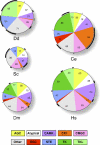The dictyostelium kinome--analysis of the protein kinases from a simple model organism
- PMID: 16596165
- PMCID: PMC1420674
- DOI: 10.1371/journal.pgen.0020038
The dictyostelium kinome--analysis of the protein kinases from a simple model organism
Abstract
Dictyostelium discoideum is a widely studied model organism with both unicellular and multicellular forms in its developmental cycle. The Dictyostelium genome encodes 285 predicted protein kinases, similar to the count of the much more advanced Drosophila. It contains members of most kinase classes shared by fungi and metazoans, as well as many previously thought to be metazoan specific, indicating that they have been secondarily lost from the fungal lineage. This includes the entire tyrosine kinase-like (TKL) group, which is expanded in Dictyostelium and includes several novel receptor kinases. Dictyostelium lacks tyrosine kinase group kinases, and most tyrosine phosphorylation appears to be mediated by TKL kinases. About half of Dictyostelium kinases occur in subfamilies not present in yeast or metazoa, suggesting that protein kinases have played key roles in the adaptation of Dictyostelium to its habitat. This study offers insights into kinase evolution and provides a focus for signaling analysis in this system.
Conflict of interest statement
Competing interests. The authors have declared that no competing interests exist.
Figures






Similar articles
-
Homology cloning of protein kinase and phosphoprotein phosphatase sequences of Dictyostelium discoideum.Dev Genet. 1991;12(1-2):45-9. doi: 10.1002/dvg.1020120109. Dev Genet. 1991. PMID: 1646694
-
cAMP-dependent protein kinase from Dictyostelium discoideum.Dev Genet. 1988;9(4-5):247-58. doi: 10.1002/dvg.1020090407. Dev Genet. 1988. PMID: 3072132 Review.
-
Comparative genomics of the social amoebae Dictyostelium discoideum and Dictyostelium purpureum.Genome Biol. 2011;12(2):R20. doi: 10.1186/gb-2011-12-2-r20. Epub 2011 Feb 28. Genome Biol. 2011. PMID: 21356102 Free PMC article.
-
Isolation and characterization of casein kinase I from Dictyostelium discoideum.Biochem J. 2000 Jul 15;349(Pt 2):527-37. doi: 10.1042/0264-6021:3490527. Biochem J. 2000. PMID: 10880352 Free PMC article.
-
Manifestations of multicellularity: Dictyostelium reports in.Trends Genet. 2005 Jul;21(7):392-8. doi: 10.1016/j.tig.2005.05.002. Trends Genet. 2005. PMID: 15975432 Review.
Cited by
-
The Kinome of Pacific Oyster Crassostrea gigas, Its Expression during Development and in Response to Environmental Factors.PLoS One. 2016 May 27;11(5):e0155435. doi: 10.1371/journal.pone.0155435. eCollection 2016. PLoS One. 2016. PMID: 27231950 Free PMC article.
-
Absence of catalytic domain in a putative protein kinase C (PkcA) suppresses tip dominance in Dictyostelium discoideum.Dev Biol. 2015 Sep 1;405(1):10-20. doi: 10.1016/j.ydbio.2015.05.021. Epub 2015 Jul 13. Dev Biol. 2015. PMID: 26183108 Free PMC article.
-
Structural and functional diversity of the microbial kinome.PLoS Biol. 2007 Mar;5(3):e17. doi: 10.1371/journal.pbio.0050017. PLoS Biol. 2007. PMID: 17355172 Free PMC article.
-
G-protein-coupled formyl peptide receptors play a dual role in neutrophil chemotaxis and bacterial phagocytosis.Mol Biol Cell. 2019 Feb 1;30(3):346-356. doi: 10.1091/mbc.E18-06-0358. Epub 2018 Dec 12. Mol Biol Cell. 2019. PMID: 30540534 Free PMC article.
-
Evolution of the phospho-tyrosine signaling machinery in premetazoan lineages.Proc Natl Acad Sci U S A. 2008 Jul 15;105(28):9680-4. doi: 10.1073/pnas.0803161105. Epub 2008 Jul 3. Proc Natl Acad Sci U S A. 2008. PMID: 18599463 Free PMC article.
References
-
- Baldauf SL, Roger AJ, Wenk-Siefert I, Doolittle WF. A kingdom-level phylogeny of eukaryotes based on combined protein data. Science. 2000;290:972–977. - PubMed
-
- Guerin NA, Larochelle DA. A user's guide to restriction enzyme-mediated integration in Dictyostelium . J Muscle Res Cell Motil. 2002;23:597–604. - PubMed
-
- Muramoto T, Suzuki K, Shimizu H, Kohara Y, Kohriki E, et al. Construction of a gamete-enriched gene pool and RNAi-mediated functional analysis in Dictyostelium discoideum . Mech Dev. 2003;120:965–975. - PubMed
Publication types
MeSH terms
Substances
LinkOut - more resources
Full Text Sources
Molecular Biology Databases

